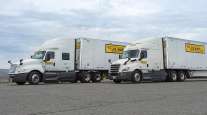J.B. Hunt Profits Power Up 55% in 2Q; Revenues Rise 24%

J.B. Hunt Transport Services reported second-quarter net earnings of $151.7 million, or $1.37 a share, up 55% from $97.9 million and 88 cents per share in the second quarter of 2017.
The Lowell, Ark.-based carrier had total operating revenue of $2.1 billion, up 24% from $1.7 billion a year ago.
J.B. Hunt attributed the rise to a variety of increases in its operating performance, though costs rose as well. Rate increases, volume growth and revenue-producing trucks were on the upside while higher expenses were seen in rail, over-the-road, outsourced dray purchase transportation, driver wages, office and support staff and technology costs.
J.B. Hunt breaks out results in four major divisions: intermodal, dedicated contract services, integrated capacity solutions and truck. Operating income by division in the quarter was 62% intermodal, 27% dedicated, 7% integrated and 4% truck.

The intermodal unit reported operating income of $134 million, up 22% from $109.7 million. Revenues rose to $1.2 billion, up 16% from $1 billion. The revenue rise was due to 4% volume growth and a 12% increase in revenue per load, which includes rate changes, fuel surcharges and freight mix. The division ran on average 5,496 tractors during the quarter, including company-owned and independent contractor tractors, compared with 5,220 a year ago.
The dedicated division had operating income of $58.5 million, up 20% from $48.6 million, while revenues jumped 29% to $530 million from $411.9 million. Revenue per truck rose 10% from a year ago. The division has added 1,284 revenue-producing trucks in the past year. The division’s final-mile services group increased its revenues by $39 million. The division carried 731,137 loads in the quarter, up 15% from 636,149 a year ago.
The integrated division saw second-quarter operating income of $14.9 million compared with a loss of $240,000 a year ago. Revenues were $347 million, up 56% from $222.5 million. The division saw volumes increase 38% and revenue per load rise by 13% due to increases in both contract and spot rates. The contract volume represented 68% of total load volume and 45% of total revenue. Hunt attributed the income improvement to a higher gross profit margin of nearly 15% compared with about 12% a year ago.
The truck division’s operating income was $7.5 million, up 35% from $5.6 million, while revenues rose 7% to $101 million from $94.6 million. The income improvement was due to higher revenue per load and lower equipment operating costs offset by driver wage increases. Customer contract rates rose 7.2%. The number of loads carried dropped to 88,301 from 96,897, but revenue per tractor per week rose 12%, to $3,935 from $3,518 a year ago.
The division was operating 1,976 tractors at the end of the quarter, compared with 2,072 a year ago. An average of 180 unseated trucks were unseated during the quarter.




